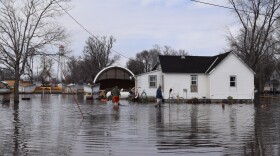The U.S. Army Corps of Engineers says it's "confident" that repairs done to federal levees along the Missouri River in southwest Iowa will make them ready to defend against the spring 2020 flood season. But even with repairs made, the levees are not quite what they used to be.
Contractors have closed 14 of 15 southwest Iowa Missouri River federal levee breaches from last year’s flooding. They are bringing these parts of the levees up to the heights they used to be before the river breached these protective embankments last spring.
“The level of repairs are basically at an interim level,” said Trish Lambert, the deputy chief of the Corps of Engineers Omaha District Systems Restoration Team. “However, we’re confident that we’ve done our best to get them to a point where they can withstand high water events.”
Lambert said while the levees are expected to reduce flood risks like they could before the March 2019 flooding, they're not back to their "full restoration" level. Contractors have armored the closed breach areas with clay on top, but they’re missing a top layer of grass that would provide extra protection and stability. The Corps would consider the areas of the levees that had breaches to not be fully restored until that grass is grown on top.
“Clay has the potential, if the water does sit against it, it’s not as resilient as if it were to have that established grass,” Lambert said.
A spokesman for the Corps said the grass provides stability for the clay “so it is not washed away during a rain/snow and high water events.”
Larry Weber, a University of Iowa civil and environmental engineering professor further explained that when water is flowing near a levee, the vegetation forms a mat that protects the surface and resists erosion, providing a security similar to what suspenders do for pants, holding things in place, he said.
“Sometimes we wear a belt and we put suspenders on too and it just adds another layer of protection,” Weber said. “The levees themselves, the compacted clays that are used, certainly provide the protection as designed, and then we're going to add an extra layer, kind of a safety factor, of making sure that we get that seeded down with a deep-rooted perennial [grass] that will hold things in place."
As the 2020 spring flood season approaches, contractors are working to close the last federal-area breach, on a levee that runs from Thurman in southwest Iowa to past the Iowa-Missouri border, by March 1, which Lambert called a "self-defined target date."
Pat Sheldon, the president of the Benton-Washington Levee District, has been watching the work that’s been done to close a breach on a levee near his home in the Percival area of Fremont County. He said he’s “pretty confident” in the level of protection the nearby levee will provide in the spring.
“The breach repairs are substantial,” Sheldon said. “They’re wider tops than what we’d had. They’re really beefy.”
Contractors working on the federal levee systems will add grass, seeding and do other final fixes after March 1, Lambert said.
Three active federal levee systems span southwest Iowa. The Corps has spent nearly $142 million so far on the contracts to repair these systems.
The National Weather Service last week released its first of three spring flood outlooks. Elevated soil moisture in the Missouri River Basin and an above-normal flow of water in rivers and streams are putting the Missouri River at an above-normal risk for spring flooding.





